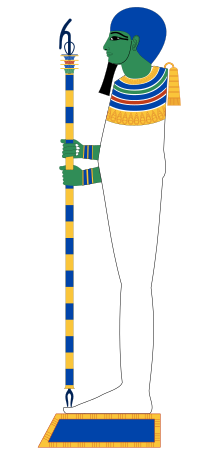This article includes a list of general references, but it lacks sufficient corresponding inline citations. (September 2017) |
| Ptah | |||||
|---|---|---|---|---|---|
 Ptah, in the form of a mummified man (except for arms and face) standing on the symbol for Ma'at, holding a scepter or staff that bears the combined ankh-djed-was symbols | |||||
| Name in hieroglyphs |
| ||||
| Major cult center | Memphis | ||||
| Symbol | the djed pillar, the bull | ||||
| Parents | none (self-created or un-created) | ||||
| Consort | Sekhmet and Bast | ||||
| Offspring | Nefertem, Maahes (in some myths), Imhotep (in later, fictitious accounts) Anat later on. | ||||
| Part of a series on |
| Ancient Egyptian religion |
|---|
 |
|
|
Ptah (/tɑː/ TAH;[1] Ancient Egyptian: ptḥ, reconstructed [piˈtaħ]; Ancient Greek: Φθά, romanized: Phthá; Coptic: ⲡⲧⲁϩ, romanized: Ptah; Phoenician: 𐤐𐤕𐤇, romanized: ptḥ)[2][3][note 1] is an ancient Egyptian deity, a creator god[4] and patron deity of craftsmen and architects. In the triad of Memphis, he is the husband of Sekhmet and the father of Nefertem. He was also regarded as the father of the sage Imhotep.
- ^ "Ptah". Lexico UK English Dictionary. Oxford University Press. Archived from the original on 22 March 2020.
- ^ CIS I 111
- ^ Ancient Egyptian, a linguistic introduction, pg 34
- ^ Allen, James P. (1988). Genesis in Egypt: The Philosophy of Ancient Egyptian Creation Accounts. Yale Egyptological Study. pp. 38–41
Cite error: There are <ref group=note> tags on this page, but the references will not show without a {{reflist|group=note}} template (see the help page).